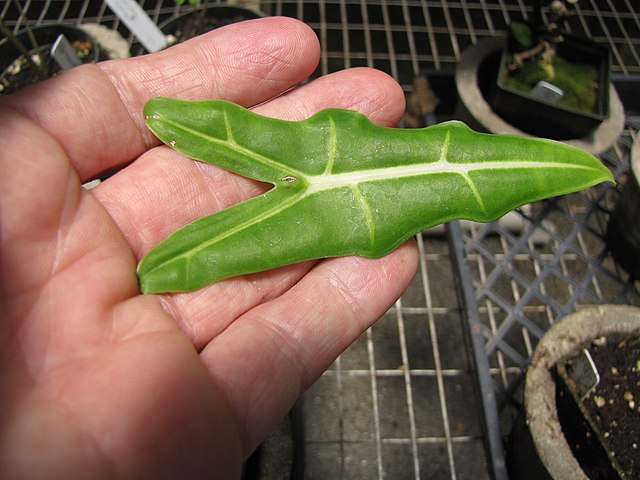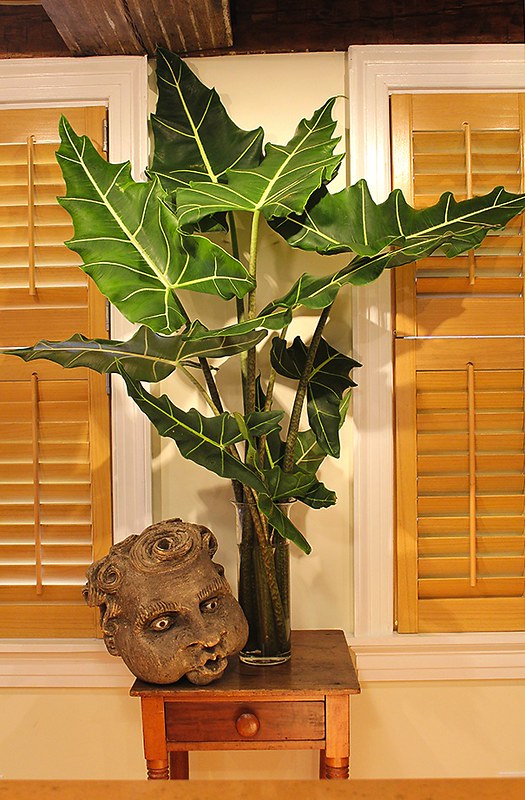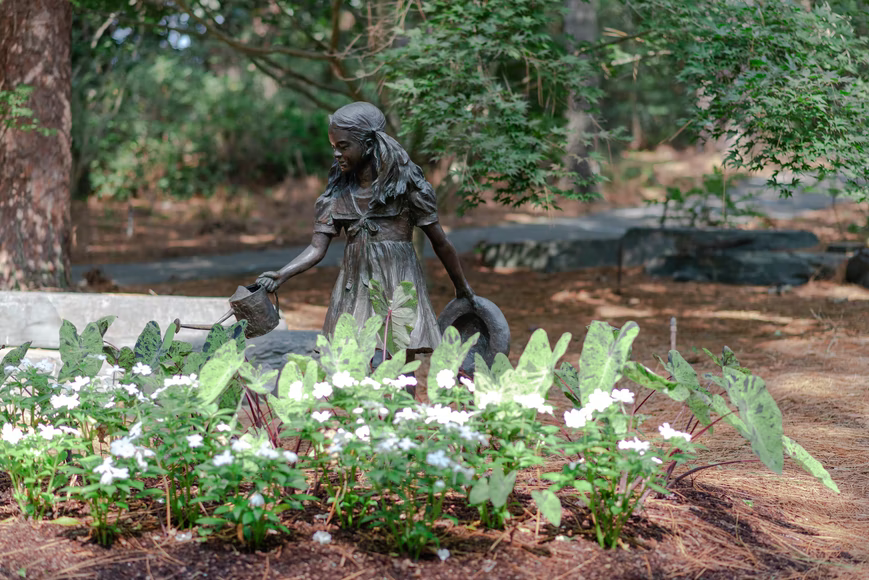The lands of Southeast Asia are graced by a beautiful, tropical perennial plant known as Alocasia Sarian. This large hybrid is one of the most extensively cultivated Alocasias globally. With its hugely attractive foliage, the Sarian alocasia is a preferable choice to add tropical vibes to any garden or home.

Here is everything you need to know and more about this majestic evergreen.
Alocasia Sarian Profile
General Information
The Alocasia Sarian plant is an elegant hybrid of Alocasia zebrina and Alocasia micholitziana. It is a tropical herbaceous plant known for its glossy, large, dark green leaves that are heart-shaped and have prominent white veins throughout. The distinct tiger-striped stems and the unique leaf appearance make it an excellent houseplant and a stunning piece in any garden.
The rhizomatous plant, native to the forests of Southeast Asia, is commonly known as the “Elephant Ear Plant” due to the shape of the giant leaves that have pointed tips. However, it is also called “African Mask” because the triangular shape also resembles the cultural masks of Africa. In addition, the white venation on the bright green leaves added to the aesthetic beauty of Sarian.
Etymology
The hybrid’s name, Sarian, is a tribute to a Filipino agricultural journalist, Zac. B. Sarian. Zac Sarian has a vast collection of Alocasias and Aglaonemas as an ornamental man.
Flowering
Like all the Arum family members, Sarian produces an inflorescence called a spadix. The inflorescence closely resembles a Calla Lily. The inflorescence has white, unscented flowers that are not known to be showy or attractively peculiar, wrapped with a leaf-like spathe.
Season Of Interest And Purchasing
The growing season of this alocasia plant is during spring and summer. During these seasons, a new leaf every week will expectedly grow. However, like any other Alocasias, the Sarian plant goes dormant in winter.
Growth
The Sarian plant is a fast-growing hybrid overall. It grows relatively faster during its growing season, summer and spring, and can take over its space during these months. It will grow to a maximum of 3-4 feet in height and a spread of 1 foot per leaf as an indoor plant. Sarian will grow up to 5-10 feet in height and produce more giant leaves when grown outdoors.
Alocasia Sarian Overview
| Scientific name | Alocasia Sarian (Alocasia zebrina x micholitziana) |
| Common name/s | Elephant Ears/ African Mask |
| Family | Araceae |
| Growth Habit | Herbaceous |
| Height and Spread | If indoors, 3-4 ft in height, 1 ft. leaf spread. If outdoors, 5-10 ft, more significant leaf spread. |
| Classification based on life cycle | Perennial |
| Origin and Distribution | Native in South East Asia. Commercially available around the world. |
| Climate Zone | Generally warmer climate |
| USDA Plant Hardiness Zone | USDA Zone 9 – 11 |
| Color | Distinct glossy green shade |

RELATED: 11 Outdoor Foliage Plants To Arrange Your Garden Like A Professional Landscape Designer
Care Tips
Light Requirement
Alocasia Sarian plants need full sun to partial sun to attain optimum growth. Specifically, 80% – 90% filtered sunlight to maintain the attractive color of the leaves. Therefore, morning or evening is best for this plant.
Like all Alocasias, avoid bright, direct sunlight to keep the leaves from burning, especially leaf tips. When put in a shady location, dust the leaves now and then to enhance their efficiency to capture light.
Temperature Requirement
The ideal temperature range of Alocasia Sarian is between 18-and 22 degrees Celsius for healthy growth. This plant appreciates indoor conditions as it is sensitive to cold temperatures. During the autumn or winter months, move the Alocasia inside to avoid severely damaging the foliage.
In general, the Sarian is not a cold temperature tolerant hybrid. It likes warm climates to thrive. Changing weather is unsuitable for growing this species because it is a little fussy about temperature changes.
Water Requirement
Moist soil is a must for Alocasias. A simple watering frequency of twice a week in summer and once a week in winter is recommended to ensure this condition. However, it is best to rely on soil dampness to know when to water. Using your fingers, press a few inches of the topsoil to check. Water only when the soil is completely dry to avoid overwatering.
RELATED: Watering Snake Plants: How Often To Water and More Helpful Tips
Humidity Requirement
A minimum of 60% humidity level is necessary for Alocasia. They don’t do well at low humidity levels, so find a perfectly damp location for this plant. In general, Sarian is a humidity-loving plant.
Indoors, it is best to put it in a bathroom or kitchen. Avoid putting Sarian near radiators to retain moisture as they quickly cause soil drying. A humidifier is also a helpful artificial method to raise humidity.
Soil Requirement
A healthy Alocasia Sarian needs well-draining soil that is light and airy. Sandy and rocky soils are not suitable grounding spaces for this plant. Soggy soil is also a no-no. As a rhizomatous Alocasia, a heavy soil mixture is also best avoided. The soil pH suitable for Sarian is slightly acidic, between 5-8.
Fertilizer Requirement
A slow-release fertilizer is suitable for Sarian. It is best added thrice a year. As a heavy feeder, liquid fertilizers are also recommended. However, it needs twice a month of fertilization to ensure optimum growth for growing pups during the growing season.
Use high-quality fertilizers, as cheap salts from low-grade ones can cause detrimental effects to plant roots. On the other hand, too much fertilizer can also induce chemical burns to the Sarian plant.
Space Requirement
Sarian alocasia needs only minimal spaces. They grow well in small areas because they prefer to be root bound.
Growing And Planting Tips

Propagation
Alocasia Sarian propagation is done using two methods. These are (1) by rhizome division from parent plants and (2) by water. Propagate in spring until late summer and never in winter during its dormancy period.
1. Propagation by Rhizome Division
Alocasia Sarian forms “clumps” or “pups,” which can be taken from the mother plant to propagate and create a new plant. Gently pull out the pups from a mature plant using a knife or sharp blade. Untangle the root system and plant them in a separate new pot that has a recommended soil mixture.
2. Propagation by Water
Submerged the pups or rhizomes taken from a parent plant in distilled water to take roots. Change the water regularly to avoid contamination by bacteria and other detrimental microorganisms. Add a small amount of liquid fertilizer or growth hormone to a newly planted pup to facilitate growth. Observe new development and shift it in the soil.
Pruning
For a fast-growing alocasia like this one, pruning is essential to keep the plant neat and managed. After six months, the plant will grow leaves in all directions, invading space for other plants nearby. Hence, it is essential to prune it now and then regularly. Utilize the pruned alocasia leaves or stems for propagation.
Moreover, the damaged or decaying leaves must be removed periodically, starting from the bottom and upward. Aside from giving the plant a fresh and healthy look, this will encourage branching and new leaf growth.
Potting And Repotting
For potting Sarian, perlite and coir fibers are recommended as these ingredients increase soil aeration and enhance drainage to avoid overwatering. A regular potting mix is enough for actively growing Alocasia.
Re-potting is only needed when Sarian plant roots are already pot-bound or when there is rhizome damage. Refresh the soil yearly. Do not immediately re-pot a newly bought plant. It is essential to acclimatize the plant first to avoid transplant shock in the new environment.
Alocasia Sarian Care
| Light | Full to partial sun, not direct |
| Temperature | Intermediate to warm, 18-22 degrees Celsius |
| Water | Once a week, increased in summer, decreased in winter |
| Soil | Well-draining, moist soil, light, and airy |
| Fertilization | Thrice a year |
| Space | Minimal space |
| Propagation | Via rhizome division and water |
| Blooming | Rarely blooms, enough sunlight and maturity needed |
| Pruning | Every six months, removal of damaged and decaying leaves |
| Potting | Regular potting mix, use of perlite and coir fibers recommended |
RELATED: Alocasia Maharani: Helpful Plant Information and Care Guide For This Rare Beauty
Problems And Troubleshooting
Overwatering
Alocasia’s drooping of leaves will tell you that it is overwatered. Visible symptoms such as wet feet and leaf yellowing, brown spots, watery blisters, and edema can be observed on leaf surfaces. Root rotting is commonly seen as a result of overwatering.
Meet the proper watering routine of your Alocasia to fix this problem. In addition, adequate care knowledge specific to this plant, such as well-draining soil, full to partial lighting, and moisture level, must be appropriately given.
Underwatering
All Alocasias show brown, crispy leaf edges and tips when underwatered. The plant soils are also cracky when proper watering is not met.
To fix this, examine the factors that could contribute to underwatering of this plant. More often than usual, this is due to the lapse in meeting the plant’s needs more often than usual. Notice your watering schedule and rectify it when needed.
However, the browning of leaves is also an indication of pot-bound roots. Re-pot it to a bigger pot and place the Sarian plant in a place with proper conditions and a humid environment.
Nutrient Deficiency
The nutrient deficiency symptoms common in most plants can also be observed in Alocasia Sarian. Yellow leaves, burnt edges and tips, leaf holes, and leaves with purplish hues and grey discoloration are commonly observed, along with brown spots, softening of texture, deformed leaves, and stunted root system. Any of these symptoms signify poor health.
To fix this, ensure that you use the right and balanced fertilizer appropriate for Alocasias. Rectify the nutrient strength. A too concentrated fertilizer mixture is detrimental to Sarian and could damage the plant instead. The soil’s acidity must also be within the range to improve nutrient uptake of Sarian.
Flowering Problems
Members of the alocasia genus do not have a significant flowering season, as they rarely flower. Therefore, to ensure that your Sarian plant will produce flowers, give the best care and requirements. Light sufficiency and maturity of the plant also play essential roles in flowering.
Pests And Diseases
Alocasia Sarian Pests And Diseases
| Common Pests/Diseases | Symptoms | Treatment and Prevention |
Common diseases include fungal diseases, stem, crown, and root rotting, leaf spotting | Black or dark brown spots with yellow rim around | Avoid overwatering and extremely high humidity. Wet environment enhances microorganism growthProper ventilation is needed around the plant. When infected, remove the plant parts affected to avoid spreading. |
| Common pests include spider mites, mealybugs, scales, thrips, and aphids | Visible insects thriving on surface | Warm, soapy water can be sprayed onto the plant. Neem oil, herbal spray, or insecticides that are commercially available can be sprayed to the plant. |
Problems With People And Animals
Toxicity
Members of the Arum family, like the Alocasia plant, have calcium oxalate crystals. These crystals are toxic to both animals and humans. They can induce irritation and swell in the throat and mouth when swallowed. Death is a possibility in the worst situations.
Alocasia Plants Meaning And Symbolism
In both the Eastern and Western versions of Jack and The Beanstalk, the “tree that grows up to the heavens” is attributed to be an Alocasia. However, scientifically, Alocasias are not trees as they are herbaceous plants.
With this attribution, alocasias are often symbols of seizing opportunities and risk-taking. Alocasias are beautiful gifts to those about to take a huge step forward in their lives and seize the day.
Alocasia Sarian Symbolism And Meaning
| General Meaning | “plant that grows up to heavens” |
| Symbolism | Risk taking and seizing opportunities |
| Cultural Significance | Attribution to the Jack and the Beanstalk fairytale |
Landscaping And Gardening Ideas

Companion Plants
Plants with foliage shaped like elephant ears or heart-shaped leaves are great additions to corners and spaces as they give off a tropical and vibrant feel. Among those that can be planted with Alocasia Sarian, a lush, equatorial aura can be achieved with great choices of Colocasia, Caladiums, Xanthosomas, and other Alocasias such as Maharani and Nebula.
Ornamental Bananas, Canna lilies, Focuses, Scheffleras, Dieffenbachias, and Coleus can also be planted as companion plants to Alocasia Sarian for a more tropical vibe.
Furthermore, pothos (Epipremnum sp.) are good companion plants with Alocasia Sarian because they thrive in similar environmental conditions. In fact, Alocasias and pothos are trendy indoor plants nowadays.
Landscaping Ideas
Add the huge Alocasia to patios and gardens, commercial landscapes, and interiorscapes to serve as a focal point. Because, its distinctive, large leaves and tiger-print stems make a bold statement to any space.
| What to plant with | Pothos, Colocasia, Caladiums, Alocasias, Xanthosomas, Coleus, Canna Lilies, Ornamental Bananas, Ficus, Dieffenbachia, Schefflera |
| What NOT to plant with | Basically nothing |
Conclusion
Finally, the Alocasia Sarian has earned its spot as one of the famous members of the Araceae family. Minimum attention is required for this plant once it is already established. However, pest resistance is relatively low for this plant species since it is a magnet to spider mites, thrips, etc.
Thus, its large and unique leaves make it one of the best plants to be a focal point in any landscape, outdoors or indoors. Hence, with the dramatic foliage and animalistic printed stems, Alocasia Sarian will fit in any traditional or modern setting.
FAQs
Is Alocasia Sarian rare?
Alocasia Sarian plants are relatively rare as they do not occur in the wild. They are an interspecific hybrid between A. zebrina and A. micholitziana.
Does Alocasia Sarian go dormant?
Yes, the Sarian plant, like most Alocasias, goes dormant during the winter season.
Can Alocasia Sarian live indoors?
Yes, definitely. Alocasia Sarian is a great indoor plant and could thrive in room conditions. Make sure to place it in its ideal growing zone inside your home.
Is Alocasia Sarian poisonous?
Definitely, yes. The presence of calcium oxalate crystals in all Alocasia species makes Sarian toxic to humans and animals.
Is Alocasia Sarian easy to care for?
Yes, minimum attention is required for this plant to thrive.
Now that you know everything about Alocasia Sarian, make sure to check out our other articles:
12 Unique Asparagus Flowers (Including Pictures)
5 Breath-taking Types Of Calathea For Your Private Tropic Corner







